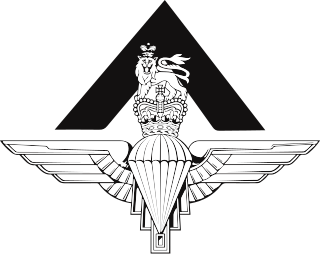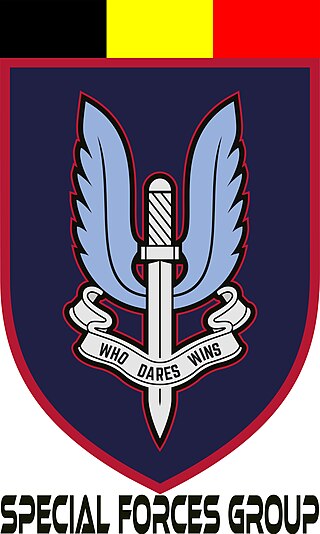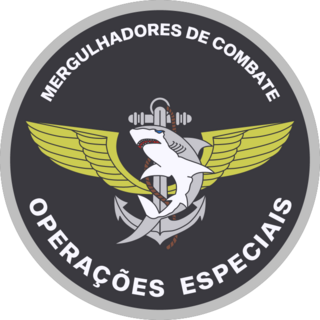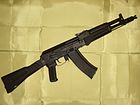
India has several Special Forces (SF) units, with the branches of the Indian Armed Forces having their own separate special forces units. The Indian Army has the Para SF, the Indian Navy has the MARCOS, and the Indian Air Force has the Garud Commando Force. There are other special forces which are not controlled by the military, but operate under civilian organisations, such as the National Security Guard under Home Ministry and Special Group under RAW. Small groups from the military SF units are deputed in the Armed Forces Special Operations Division, a unified command and control structure.

The Commandos Marine are the special operation forces (SOF) of the French Navy. The Commandos Marine are nicknamed Bérets Verts. They operate under the Maritime Force of Sailor riflemen and Navy Commandos (FORFUSCO) and form part of the French Special Operations Command.

A parachutist badge is a badge awarded by armed forces or paramilitary forces of many states to personnel who have received parachute training and completed the required number of jumps. It is difficult to assess which country was the first to introduce such an award.

The Parachutist Badge, also commonly referred to as "Jump Wings", is a military badge of the United States Armed Forces. Some services, such as the Marine Corps, officially refer to it as an insignia instead of a badge. The United States Space Force and United States Coast Guard are the only branches that do not award the Parachutist Badge, but their members are authorized to receive the Parachutist Badges of other services in accordance with their prescribed requirements. The DoD military services are all awarded the same Military Parachutist Badge. The U.S. Army and U.S. Air Force issue the same Senior and Master Parachutist Badges while the U.S. Navy and U.S. Marine Corps issue the Navy and Marine Corps Parachutist Insignia to advanced parachutists. The majority of the services earn their Military Parachutist Badge through the U.S. Army Airborne School.

The Pathfinder Platoon is a pathfinder unit of the British Army, and an integral part of 16 Air Assault Brigade. The Pathfinder Platoon acts as the brigade's advance force and reconnaissance force. Its role includes locating and marking drop zones and helicopter landing zones for air landing operations. Once the main force has landed, the platoon provides tactical intelligence and offensive action roles for the brigade.

The Marine Commandos, abbreviated to MARCOS and officially called the Marine Commando Force (MCF), are the special forces of the Indian Navy. The MARCOS were originally named Indian Marine Special Force, which was later changed to Marine Commando Force to impart "an element of individuality" to it, according to the Indian Navy. The abbreviation 'MARCOS' was coined afterwards.

The Commandement des Opérations Spéciales or COS is a joint staff charged with overseeing the various special forces of the French Army, Navy and Air and Space Force, bringing them all under a single operational authority. The command is placed under the orders of the Chief of Defence Staff and under the direct authority of the President of the French Republic.

The Special Actions Detachment or DAE is the tier one special force maritime unit of the Portuguese Navy. It is part of the Portuguese Marine Corps. Raised in 1985, the DAE is one of the smallest special forces units within the Portuguese Armed Forces. It is responsible for conducting air-sea rescue, amphibious reconnaissance, amphibious warfare, black operation, bomb disposal, CBRN defense, coastal raiding, counterterrorism, direct action, executive protection, hostage rescue, irregular warfare, ISTAR, long-range penetration, JTAC, manhunt high-value target, maritime sabotage, mountain rescue, naval boarding, operation behind high risk enemy lines, special operations, special reconnaissance, tracking targets, underwater demolition, unconventional warfare, other missions in support of Portuguese and NATO armed forces. DAE's mission and training are similar to American special forces and it often trains with them.

The 1st Marine Infantry Parachute Regiment or 1er RPIMa is a unit of the French Army Special Forces Command, therefore part of the Special Operations Command.

The maroon beret in a military configuration has been an international symbol of airborne forces since the Second World War. It was first officially introduced by the British Army in 1942, at the direction of Major-General Frederick "Boy" Browning, commander of the British 1st Airborne Division. It was first worn by the Parachute Regiment in action in North Africa during November 1942.

The Special Forces Group is the special forces unit in the Land Component of the Belgian Armed Forces.

The Combat Divers Group, abbreviated to GRUMEC, is a special operations and counterterrorism unit of the Brazilian Navy. Their main attributions include tasks such as reconnaissance, sabotage, hostage rescue and the elimination of targets of strategic value in maritime and riverine environments.

The Marine Corps Special Operations Battalion, also known as Tonelero Battalion or Amphibious Commandos (COMANF), is a special operations battalion of the Brazilian Marine Corps. Its attributes include planning, conducting and executing special reconnaissance, direct action, counterterrorism and hostage rescue operations in support of Brazilian Marine Corps operations.

7 Medical Battalion Group is the specialist Airborne Medical Unit of the South African Military Health Service. The Battalion's main task is to render medical support to the South African Airborne and Special Forces. The unit falls under the command of the Mobile Military Health Formation.

The 44 Pathfinder Platoon is part of the 44 Parachute Regiment. The pathfinder is a trained and specialized paratrooper, who performs covertly behind enemy lines, either in small groups or in collaboration with other reconnaissance units.
The National Special Operations Force (NSOF) has been Malaysia's main security force which serves as the first responder to any terror threats on the country's sovereignty after October 2016. The force covers elements from the Malaysian Armed Forces, Royal Malaysia Police and the Malaysian Maritime Enforcement Agency.
The 104th Operational Maneuvers Regiment is a special forces regiment of the Algerian Land Forces, and is also a parachute regiment.
























